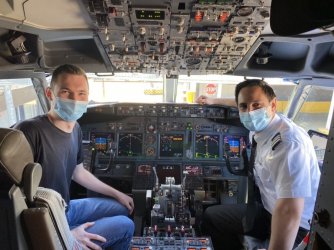AviatorInsight
Established Member
- Joined
- Oct 5, 2016
- Posts
- 1,396
They’re….fun.Interested in the personality traits that would make someone a zero extra fuel man.
They’re….fun.Interested in the personality traits that would make someone a zero extra fuel man.
No fixed answer to that. But, on the day, diversion fuel was the actual requirement, so any extra you added would be based on whatever you thought was the likely hold...and that's the length of a bit of string. Probably in the order of 10 tonnes, and you'd be planning on it actually being burnt.How much fuel uplifted to carry the holding fuel + holding fuel?
Only once that I can recall. Funnily enough the zero fuel man mentioned above, was actually doing an annual route check on me at the time, and he almost had heart failure when I bumped all of the cargo and replaced it with fuel. As it turned out, that extra was the only reason we ended up at destination.Have you ever converted payload to holding fuel?. That would double whammy the bean counters.....
Aren't we all.Interested in the personality traits that would make someone a zero extra fuel man.
was a good laugh
Ah Ok.zero fuel man mentioned above, was actually doing an annual route check on me
There’s no formula as such that I use but as a general rule I’ll take an extra tonne on top of the flight plan. It gives me go around fuel without having to do the low fuel checklist halfway around at low level.So when deciding to take extra fuel, is it "gut feeling" or do you have your own formula's (which could be written down) that you use to determine how much extra?

I used to ask the SOs and FO for their proposed fuel order, before inserting my own. I recall one flight for which the answers were, zero, 2 tonnes, 6 tonnes. The low figure was a company man in training. The two tonne man probably wanted more, but didn‘t feel he could justify it. The FOs 6 tonnes was reasonable. I actually ordered 11 tonnes.
I remember being in coughpit as a 5 or 6 yo. My earliest memory of being on an aircraft. I didn't become a pilot, but remember it as a thrill. Have to dig up the photo. Every other memory as a child was throwing up, turbulence used to knock me around a lot.I had the pleasure of being flown from CBR to MEL this morning by the one and only @AviatorInsight! Great, smooth flight and he gave me a little tour of the flight deck after landing.
View attachment 267500
AFF Supporters can remove this and all advertisements
Great to see some pilots still get involved in this.
Did you ask them first?I used to ask the SOs and FO
I understand it does not mean "arrive" at the gate and the aircraft is still in the air. At what point have you "arrived"?arriving with 7 tonnes
How much extra fuel to carry TSV from CNS?Even going to CNS on a clear day I’ll always carry TSV as an alternate.
About 2 tonnes. And no never had unusable fuel issues for CoG.How much extra fuel to carry TSV from CNS?
.......
Fuel and CoG
Have you ever had unusable fuel due to CoG issues?
Its a short distance - only approx 150nm. Are you including GA fuel for alternate as well?About 2 tonnes
Nope. None of them would have been ok.So was that a flight which the company man would have gotten away with it, or did that extra fuel come in handy?
I didn't have to justify anything to them.Also what reason do you use for justification to the company when ordering additional fuel?
Of course, anything else would be effectively giving away the answer.Did you ask them first?
Yes, and if they have a better idea, then you can claim it.Back to Captain Sean 787 captain who was faculty in our medical sim centre, during discussions about the human factors aspect of performance under stress he said a good practice is to ask the junior members of the team what they thought first, because if the "senior" or "leader" says what s/he thinks then the underlings tend to agree with the proposition which does not promote diversity of thought.
The flight, for fuel purposes, ends at the end of the landing roll. It's generally a good idea to have enough to make it from there to the gate though.I understand it does not mean "arrive" at the gate and the aircraft is still in the air. At what point have you "arrived"?
What in? 747? You'd need to leave TSV (i.e. go around with) about 12 tonnes. I recall diverting from London to Amsterdam, which is about 60 nm further, and I think the figure was 13.8 tonnes.How much extra fuel to carry TSV from CNS?
Not that I recall. It could be a big issue in the 380 with certain pump failure scenarios.Fuel and CoG
Have you ever had unusable fuel due to CoG issues?
It's a pity that all went away after 911. I rarely left a jump seat empty, especially into HK.My absolute highlight was a QF B742 arriving LHR, May 1989.
It was 4 May 1989.Rome to London is unusual. Around that time frame, Rome was generally serviced by flights from Athens. I do recall one that I did from London, but don't have the details.
Yes, it’s calculated using the fuel from B-C + a 30NM SID allowance, + a 30NM STAR allowance (which is manoeuvre fuel) + 10% contingency. The manoeuvre fuel is added to account for additional fuel burnt during the missed approach, departure from the destination and approach at the destination alternate.Its a short distance - only approx 150nm. Are you including GA fuel for alternate as well?

